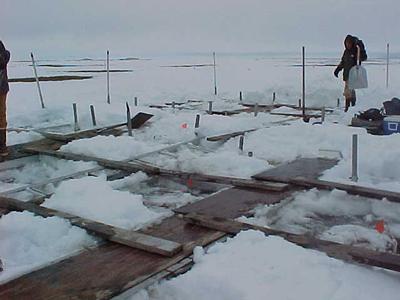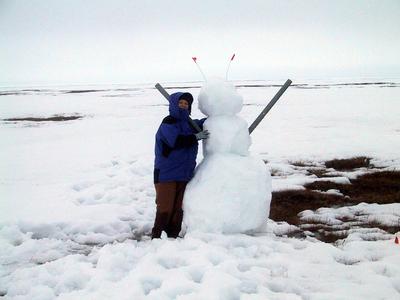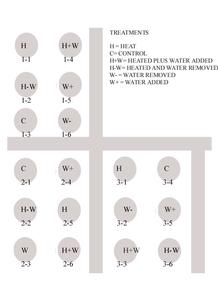
|
6 June, 2001Wednesday Today was our first real day out in the field. Like any job a lot of time is spent in preparing the job site. The same is true here. We spent all day preparing our (job) research site. Glen, Spring and I shoveled snow off the site to uncover the 18 experimental plots. The entire site is approximately 20 feet by 40 feet and each circle is 24 inches in diameter. (A diagram of the site is included below.) We cleared the snow from between the plots (circles). We will be placing a tight fitting frame around each circle and then we will anchor a clear, square, plastic chamber to each. This will enable us to measure carbon fluxes (changes) experienced by the enclosed vegetation. We were careful not to disturb the tundra within the plots. As you can see from the picture below there was still snow all around but now the melting will proceed faster. Since we are recording carbon fluxes the entire area within each of the circles has to be exposed and growing. We plan to return to the site in a few days. A number of the rings were sitting in puddles of water that we might have to siphon on our return. A few thoughts on tundra to explain why there are such large amounts and areas of puddled water that develop after snow melt. Notice the standing water to the right of the snowman (woman) below. You can see exposed ground, which you would assume would absorb the snows' melt water. The low plants, which you see covering the ground are a part of what is called the "active layer." Right now the active layer stops 1/2 inch down, just below the tops of the vegetation. Under this the ground is frozen solid. The puddled water cannot flow down, hence, lots of puddles and later in the season, lots of mosquitoes. The puddled water, since it is above freezing, will also act in melting the active layer. A heat exchange will occur here. The active layer is that part of the ground which freezes and thaws during the year and can be anywhere from a few inches deep to approximately 2 meters (6 feet) under the surface. Below the active layer lays the "permafrost" and as the name implies this is the part of the ground that never thaws. Getting to and from the site with equipment also involves alot of physical energy. Our van is parked about half mile away and all the supplies have to be walked in. The tundra is extremely fragile and once disturbed, by tires or even too many people walking over the same spot often, will scar the area interrupting plant growth. %&% Many people think of the northern tundra as a flat, desolate area of land which is so extreme that not much could be supported on it anyway - so who cares? I plan to explore the importance of this unique and productive ecosystem and showcase the wildlife, which uses and depends on this area for their survival. But just as important as the wildlife, which depends on the area, are the unseen processes that occur here. The San Diego State University project is studying the tundra as a vital player in the earth's system as a whole and how it interacts with the atmosphere, hydrosphere, biosphere, cryosphere (ice) and lithosphere in effecting the earth's climate. The URL for PISCES Program in yesterdays journal was incorrect. The correct one is : www.sdsa.org/pisces/arctic.html
Contact the TEA in the field at . If you cannot connect through your browser, copy the TEA's e-mail address in the "To:" line of your favorite e-mail package. |










